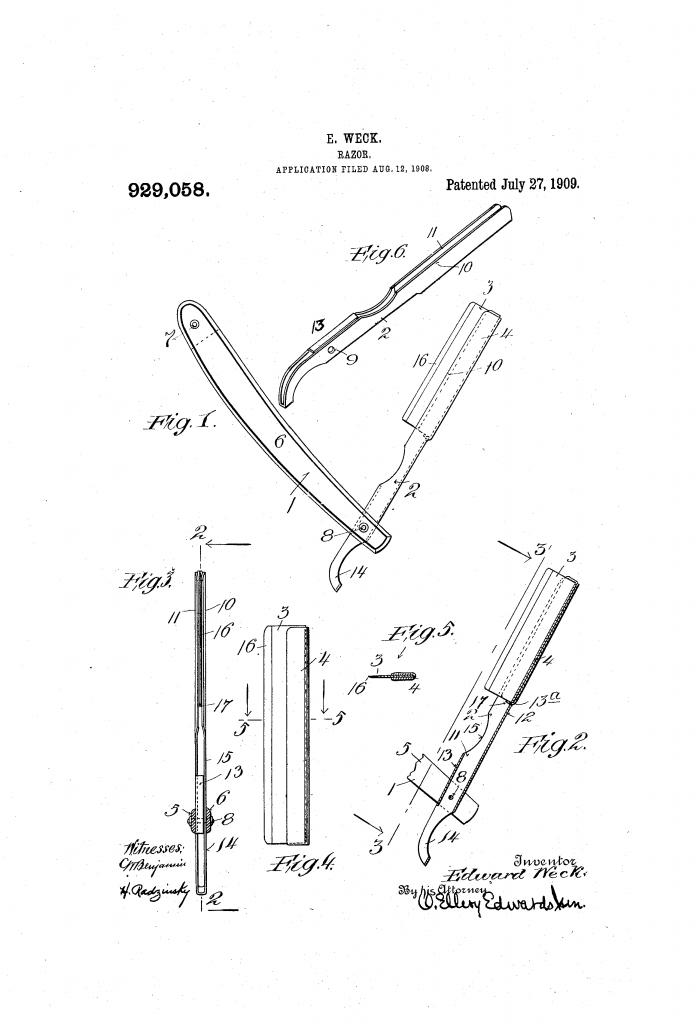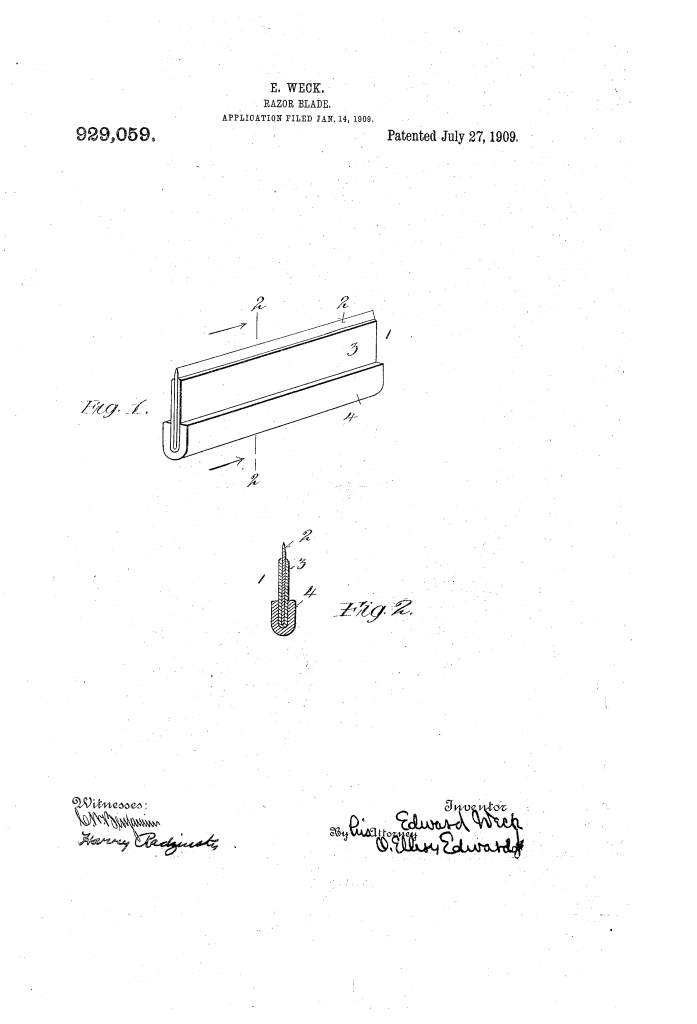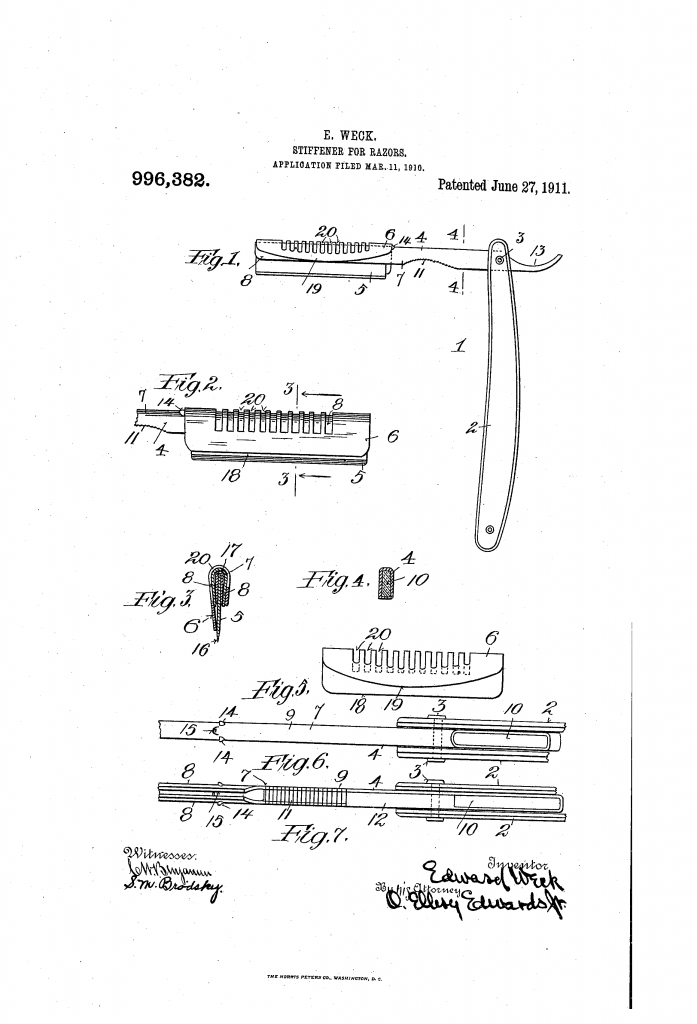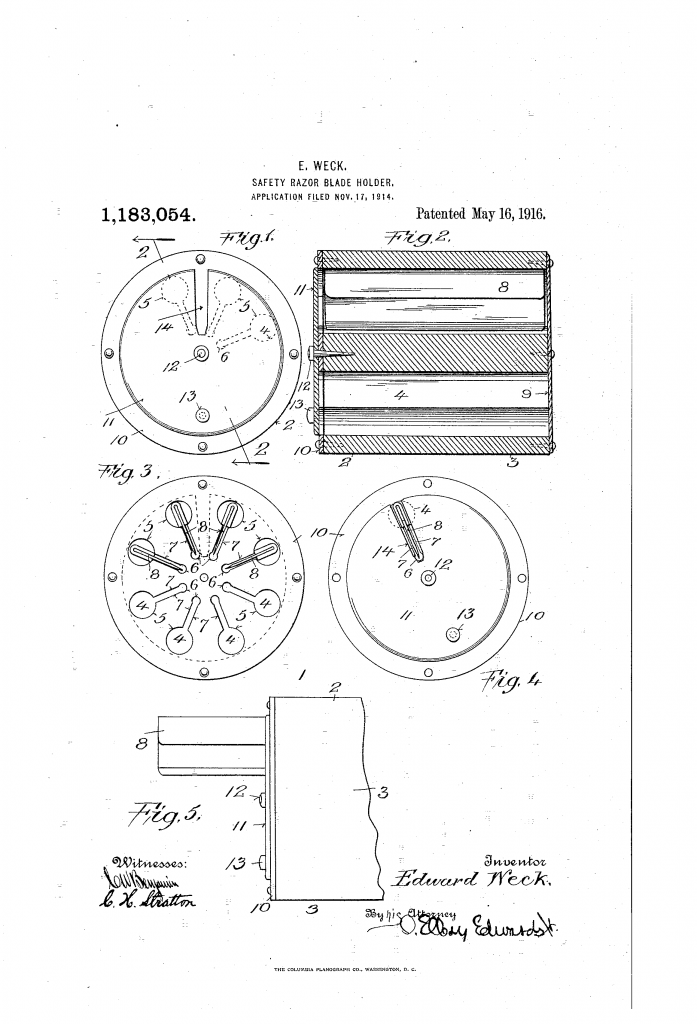Between 1908 and 1914, Edward Weck was granted four patents which, when taken together, creates a full on shaving system centred around a shavette – a shavette system if you want. Interestingly enough, this was around the same time as another shaving system was patented. And much like Clark’s system, Weck’s shavette system contained a razor, a blade, and a way to package the blades. Weck also came up with a stiffener, to make the blade stiffer.
The Razor
The first patent covers a razor and a blade.1 Much like Gillette’s original patent, the core of Weck’s idea was to provide a razor where you would replace the blade. In the words of the patent:
The object of this invention is to provide an article of this class with a removable blade so that whenevera blade becomes dull, it may be removed and a new one substituted therefor.
From US patent 929,058

The razor looks – to my eye at least – very much like a traditional straight razor. WHere you would expect to find the blade and tang, however, there is a folded sheet metal holder that the blade would get inserted into.
The blade in the original patent looks very much like an elongated GEM blade – a hardened core with a sheet metal backing wrapped around the non-edge side.
All in all a pretty solid patent by itself. But it seems that Weck wanted2 more.
The Blade
An obvious item to improve on a razor with replaceable blades is the blades. Most traditional knife blades are laminated.3 This means that you’ll have a hard and brittle core that will take a sharp edge. Surrounding the brittle core you’ll have softer steel – unable to take a good edge, but much more resilient to breakage.

Weck’s improved blade that would go with the shavette system is made up of three parts. A blade strip made of hard steel with a ground edge. A folded mild steel reinforcement that extended all the way to the bevel. And a thicker and heavier mild steel reinforcement that extended less than halfway up the side.
Weck claimed there were several benefits of this multipart construction. Mainly that the blade would be more rigid while retaining a flexible edge. If there were more benefits than these two, he forgot to put it in the patent.
The Stiffener
Two years after Weck got his patents for the razor and improved blade, he got a patent for a stiffener for razors. The purpose of such a thing seems a little mysterious to me, so let us see what the patent text has to say:
The object of my invention is to provide a wafer blade razor, with a suitable stiffener which will so stiffen the blade so that it can be used advantageously under severe conditions of service.
From US patent 996,382
So it seems like Weck though that the blades for his razor were not stiff enough for shaving a heavy beard. A folded over sheet metal piece was his solution.

The patent for the stiffener goes into quite a bit of details of the razor and blade too, but it is broadly the same as his original shavette patent. The stiffener is described as being made of sheet metal, with one side almost touching the cutting edge, and the other being shorter. It had a number of recesses along the back. These, the patent claims, gives the stiffener a more neat appearance.4
The Safety-Razor-Blade Holder
Once you have a shavette system using replaceable blades, you need a way to store and distribute said blades. While a wrapping like the one Kaufman patented would work,5 Weck patented a different solution a few years after the other patents. As an added bonus, Weck’s holder was reusable.

The holder consists of a cylinder, in which there is a number of slots. The slots are shaped so that the reinforcing backing of the blade rides on shoulders, so the edge will not touch the bottom of the slot.
On one end of the cylinder is a rotating lid, which can be turned to expose one slot at a time. When the slot is exposed, a blade can be extracted. Or inserted, if so desired.
Thoughts on the shavette system
In all fairness, I don’t actually know if Edward Weck actually saw these four patents as a system, or as a series of improvements of his original idea. But then again, I don’t know if Gillette saw his idea of a thin, replaceable blade and a holder for it as a shaving system either.
All told I think the four patents would have served as the basis for a viable ecosystem. All the elements are in place; a razor that looks the part, sensible blades, and a blade holder for distributing and storing the blades. The blade stiffener is an added bonus for those who have steel wool stubble.
According to Waits’ Compendium, Weck mananged to get his razor manufactured under the tradename of Sextoblade.6 Again according to Waits, the tradename was renewed in 1930. this implies that the razor and blades were successful enough to survive for at least two decades. Waits’ Compendium also have pictures7 of what looks very much like the patented stiffener.
It is unusual for me to write about a patent that actually resulted in a manufactured razor. But it is nice to see that not all patented razors disappears without a trace.
You can read the full patents for the shavette, the improved blade, the stiffener, and the safety-razor-blade holder at Google Patents.
Footnotes
- Which would be improved in the second patent.
- And wanted it bad enough to pay for more patents.
- Other ways of achieving the same is damasking the blade., or pattern welding it like the Norse did with swords.
- And prevent the stiffener from being too rigid.
- But was already patented by Kaufman, and I assume Weck wasn’t interested in paying royalties.
- Trademark filed in July 1908, about a year before he was granted the patent for the razor.
- On page 306 of the PDF v1.21

Pingback: The shavette system of Edward Weck - Razors n Blades the shave that saves